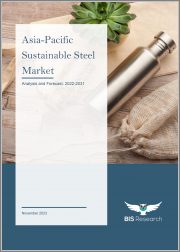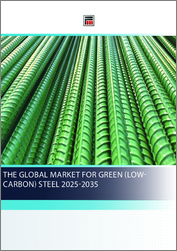
|
시장보고서
상품코드
1379165
아시아태평양의 지속 가능한 철강 시장(2022-2031년)Asia-Pacific Sustainable Steel Market - Analysis and Forecast, 2022-2031 |
||||||
중국을 제외한 아시아태평양의 지속가능한 철강 시장 규모는 2022년 684억 달러에서 예측 기간 동안 9.39%의 CAGR을 나타내고, 2031년 1,534억 달러 규모로 성장할 것으로 예상됩니다.
| 주요 시장 통계 | |
|---|---|
| 예측 기간 | 2022-2031년 |
| 2022년 평가 | 684억 달러 |
| 2031년 전망 | 1,534억 달러 |
| CAGR | 9.39% |
이 시장의 성장은 엄격한 정부 규제, 탄소중립 목표, 재생강 사용의 에너지 효율성, 에너지 및 원자재 공급의 유한성으로 인한 철강 수요의 대폭적인 증가에 의해 주도될 것으로 예상되고 있습니다. 그러나 부적절한 분리 및 복잡한 제품 설계로 인한 회수강재 내 오염물질과 같은 문제, 그리고 그린스틸의 높은 제조비용 등이 큰 걸림돌로 작용하고 있습니다.
지속가능한 철강 시장을 주도하고 있는 아시아태평양은 저탄소 제조 기술, 자원 효율성 및 환경 친화적 인 비즈니스 관행에 초점을 맞추었습니다. 강화된 환경 규제, 탄소 중립에 대한 관심 증가, 저렴하고 효율적인 철강 제조에 대한 필요성 등 여러 가지 상호 연관된 요인들이 이 산업을 주도하고 있습니다. 지속 가능한 철강은 인프라, 자동차, 건설 등 다양한 산업 수요를 충족시키는 동시에 철강 생산이 환경에 미치는 영향을 줄여야 한다는 시급한 요구에 부응하고 있습니다.
본 보고서는 세계 아시아태평양의 지속가능한 철강(Sustainable Steel) 시장을 조사했으며, 시장 개요, 시장 성장에 영향을 미치는 각종 영향요인 분석, 규제 환경, 시장 규모 추이 및 예측, 각종 부문별/지역별/주요 국가별 상세 분석, 경쟁 구도, 주요 기업 분석 등의 정보를 정리하여 전해드립니다.
시장 구분 :
세분화 1: 최종 사용자별
- 운송
- 건축 및 건설
- 가구 및 가전제품
- 포장
- 기타
세분화 2: 기술별 세분화
- Electric Arc Furnace (EAF)
- Blast Furnace-Basic Oxygen Furnace (BF-BOF)
- 기타
세분화 3: 국가별
- 일본
- 인도
- 한국
- 기타 아시아태평양
목차
제1장 시장
- 업계 전망
- 동향 : 현재와 미래
- 공급망 분석
- COVID-19의 지속가능한 스틸 시장에 대한 영향
- 러시아와 우크라이나 전쟁이 지속가능한 스틸 시장에 미치는 영향
- 에코시스템/진행 중인 프로그램
- 사업 역학
- 사업 촉진요인
- 사업상 과제
- 사업 전략
- 경영전략
- 사업 기회
- 스타트업 상황
- 특허 분석
- 세계 및 지역 레벨 : 평균 가격 분석
- 세계의 그린 스틸 프로젝트와 개발
제2장 아시아태평양
- 중국
- 시장
- 용도
- 제품
- 아시아태평양 및 일본
- 시장
- 용도
- 제품
- 아시아태평양의 지속가능한 스틸 시장(국가별)
- 아시아태평양 및 일본(국가별)
제3장 시장 : 경쟁 벤치마킹 및 기업 개요
- 경쟁 벤치마킹
- 기업 개요
- HBIS GROUP
- NIPPON STEEL CORPORATION
- POSCO
- Tata Steel
- ScrapBuk
제4장 조사 방법
LSH 23.11.24“The Asia-Pacific Sustainable Steel Market (excluding China) Expected to Reach $153.4 Billion by 2031.”
| KEY MARKET STATISTICS | |
|---|---|
| Forecast Period | 2022 - 2031 |
| 2022 Evaluation | $68.4 Billion |
| 2031 Forecast | $153.4 Billion |
| CAGR | 9.39% |
Introduction to Asia Pacific (APAC) Sustainable Steel Market
The Asia-Pacific sustainable steel market (excluding China) is projected to reach $153.4 billion by 2031 from $68.4 billion in 2022, growing at a CAGR of 9.39% during the forecast period 2022-2031. The expansion of the Asia-Pacific sustainable steel market is anticipated to be driven by strict government regulations, carbon neutrality objectives, energy efficiency in the use of recycled steel, and a significant increase in steel demand as a result of finite energy and raw material supplies. However, challenges like contaminants in recovered steel from improper separation and complex product designs, in addition to high production costs of green steel in the face of significant infrastructure costs and green hydrogen prices, constitute significant market barriers in this area.
Market Introduction
Leading the way in the sustainable steel market is the Asia-Pacific area, which places a strong emphasis on the use of low-carbon manufacturing techniques, resource efficiency, and environmentally friendly practices. Many interrelated issues, such as tightening environmental regulations, the increased focus on carbon neutrality, and the need for affordable and efficient steel manufacturing, are driving the industry. In the Asia-Pacific area, sustainable steel is becoming more and more popular. It meets the needs of a variety of industries, such as infrastructure, automotive, and construction, while also meeting the urgent need to lessen the environmental impact of steel production.
Market Segmentation
Segmentation 1: by End-Use Application
- Transportation
- Building and Construction
- Furniture and Appliances
- Packaging
- Others
Segmentation 2: by Technology
- Electric Arc Furnace (EAF)
- Blast Furnace-Basic Oxygen Furnace (BF-BOF)
- Others
Segmentation 3: by Country
- Japan
- India
- South Korea
- Rest-of-Asia Pacific
How can this report add value to an organization?
Product/Innovation Strategy: The product segment helps the reader understand the different types of sustainable steel available and their potential in the asia-pacific region. Moreover, the study provides the reader with a detailed understanding of the different sustainable steel end-use applications in industries such as transportation, building and construction, furniture and appliances, packaging, and others.
Growth/Marketing Strategy: Business expansions, partnerships, acquisitions, collaborations, and joint ventures are some key strategies adopted by key players operating in the space.
Competitive Strategy: Key players in the APAC sustainable steel market analyzed and profiled in the study involve sustainable steel providers. Moreover, a detailed competitive benchmarking of the players operating in the APAC sustainable steel market has been done to help the reader understand how players stack against each other, presenting a clear market landscape. Additionally, comprehensive competitive strategies such as partnerships, agreements, and collaborations will aid the reader in understanding the untapped revenue pockets in the market.
Key Market Players and Competition Synopsis
The companies that are profiled have been selected based on inputs gathered from primary experts and analysing company coverage, product portfolio, and market penetration.
Some of the prominent names established in this market are:
|
|
Table of Contents
1 Markets
- 1.1 Industry Outlook
- 1.1.1 Trends: Current and Future
- 1.1.1.1 Rising Investments in Green Technologies
- 1.1.1.2 Change in Business Models of Companies due to Climate Action
- 1.1.2 Supply Chain Analysis
- 1.1.3 Impact of COVID-19 on the Sustainable Steel Market
- 1.1.4 Impact of Russia and Ukraine War on the Sustainable Steel Market
- 1.1.5 Ecosystem/Ongoing Programs
- 1.1.5.1 Associations
- 1.1.1 Trends: Current and Future
- 1.2 Business Dynamics
- 1.2.1 Business Drivers
- 1.2.1.1 Stringent Regulations and Carbon Neutrality Targets
- 1.2.1.2 Energy and Cost Efficiency owing to the Use of Recycled Steel
- 1.2.1.3 Significant Increase in Steel Demand with Scarcity of Raw Materials and Energy
- 1.2.2 Business Challenges
- 1.2.2.1 Impurities due to Incomplete Separation and Complex Product Design
- 1.2.2.2 High Infrastructure Cost and Green Hydrogen Prices Curbing the Green Steel Developments
- 1.2.3 Business Strategies
- 1.2.3.1 Market Developments
- 1.2.3.2 Product Developments
- 1.2.4 Corporate Strategies
- 1.2.4.1 Partnerships, Acquisitions, Collaborations, and Joint Ventures
- 1.2.5 Business Opportunity
- 1.2.5.1 Increasing Demand for Green Steel across the Value Chain
- 1.2.5.2 Development of Economic and Environmental Technologies
- 1.2.1 Business Drivers
- 1.3 Start-Up Landscape
- 1.3.1 Key Start-Ups in the Ecosystem
- 1.4 Patent Analysis
- 1.4.1 Patent Analysis (by Status)
- 1.4.2 Patent Analysis (by Leading Countries)
- 1.5 Global and Regional Level: Average Pricing Analysis
- 1.6 Global Green Steel Projects and Developments
2 Asia-Pacific
- 2.1 China
- 2.1.1 Market
- 2.1.1.1 Buyer Attributes
- 2.1.1.2 Key Manufacturers/Suppliers in China
- 2.1.1.3 Business Challenges
- 2.1.1.4 Business Drivers
- 2.1.2 Application
- 2.1.2.1 China Sustainable Steel Market (by End-Use Application), Volume and Value Data
- 2.1.3 Product
- 2.1.3.1 China Sustainable Steel Market (by Technology), Volume and Value Data
- 2.1.1 Market
- 2.2 Asia-Pacific and Japan
- 2.2.1 Market
- 2.2.1.1 Key Manufacturers/Suppliers in Asia-Pacific and Japan
- 2.2.1.2 Business Challenges
- 2.2.1.3 Business Drivers
- 2.2.2 Application
- 2.2.2.1 Asia-PacificSustainable Steel Market (by End-Use Application), Volume and Value Data
- 2.2.3 Product
- 2.2.3.1 Asia-PacificSustainable Steel Market (by Technology), Volume and Value Data
- 2.2.4 Asia-Pacific Sustainable Steel Market (by Country), Volume and Value Data
- 2.2.5 Asia-Pacific and Japan (by Country)
- 2.2.5.1 Japan
- 2.2.5.1.1 Market
- 2.2.5.1.1.1 Buyer Attributes
- 2.2.5.1.1.2 Key Manufacturers/Suppliers in Japan
- 2.2.5.1.1.3 Business Challenges
- 2.2.5.1.1.4 Business Drivers
- 2.2.5.1.2 Application
- 2.2.5.1.2.1 Japan Sustainable Steel Market (by End-Use Application), Volume and Value Data
- 2.2.5.1.3 Product
- 2.2.5.1.3.1 Japan Sustainable Steel Market (by Technology), Volume and Value Data
- 2.2.5.1.1 Market
- 2.2.5.2 South Korea
- 2.2.5.2.1 Market
- 2.2.5.2.1.1 Buyer Attributes
- 2.2.5.2.1.2 Key Manufacturers/Suppliers in South Korea
- 2.2.5.2.1.3 Business Challenges
- 2.2.5.2.1.4 Business Drivers
- 2.2.5.2.2 Application
- 2.2.5.2.2.1 South Korea Sustainable Steel Market (by End-Use Application), Volume and Value Data
- 2.2.5.2.3 Product
- 2.2.5.2.3.1 South Korea Sustainable Steel Market (by Technology), Volume and Value Data
- 2.2.5.2.1 Market
- 2.2.5.3 India
- 2.2.5.3.1 Market
- 2.2.5.3.1.1 Buyer Attributes
- 2.2.5.3.1.2 Key Manufacturers/Suppliers in India
- 2.2.5.3.1.3 Business Challenges
- 2.2.5.3.1.4 Business Drivers
- 2.2.5.3.2 Application
- 2.2.5.3.2.1 India Sustainable Steel Market (by End-Use Application), Volume and Value Data
- 2.2.5.3.3 Product
- 2.2.5.3.3.1 India Sustainable Steel Market (by Technology), Volume and Value Data
- 2.2.5.3.1 Market
- 2.2.5.4 Rest-of-Asia-Pacific and Japan
- 2.2.5.4.1 Market
- 2.2.5.4.1.1 Buyer Attributes
- 2.2.5.4.1.2 Key Manufacturers/Suppliers in Rest-of-Asia-Pacific and Japan
- 2.2.5.4.1.3 Business Challenges
- 2.2.5.4.1.4 Business Drivers
- 2.2.5.4.2 Application
- 2.2.5.4.2.1 Rest-of-Asia-Pacific and Japan Sustainable Steel Market (by End-Use Application), Volume and Value Data
- 2.2.5.4.3 Product
- 2.2.5.4.3.1 Rest-of-Asia-Pacific and Japan Sustainable Steel Market (by Technology), Volume and Value Data
- 2.2.5.4.1 Market
- 2.2.5.1 Japan
- 2.2.1 Market
3 Markets-- Competitive Benchmarking & Company Profiles
- 3.1 Competitive Benchmarking
- 3.1.1 Competitive Position Matrix
- 3.1.2 Product Matrix for Key Companies
- 3.1.3 Market Share Analysis of Key Companies
- 3.2 Company Profiles
- 3.2.1 HBIS GROUP
- 3.2.1.1 Company Overview
- 3.2.1.1.1 Role of HBIS GROUP in the Sustainable Steel Market
- 3.2.1.1.2 Product Portfolio
- 3.2.1.1.3 Business Strategies
- 3.2.1.1.3.1 Market Development
- 3.2.1.1.4 Corporate Strategies
- 3.2.1.1.4.1 Partnerships, Acquisitions, Collaborations, and Joint Ventures
- 3.2.1.1.5 Analyst View
- 3.2.1.1 Company Overview
- 3.2.2 NIPPON STEEL CORPORATION
- 3.2.2.1 Company Overview
- 3.2.2.1.1 Role of NIPPON STEEL CORPORATION in the Sustainable Steel Market
- 3.2.2.1.2 Product Portfolio
- 3.2.2.1.3 Business Strategies
- 3.2.2.1.3.1 Market Development
- 3.2.2.1.3.2 Product Development
- 3.2.2.1.4 Corporate Strategies
- 3.2.2.1.4.1 Partnerships, Acquisitions, Collaborations, and Joint Ventures
- 3.2.2.1.5 R&D Analysis
- 3.2.2.1.6 Analyst View
- 3.2.2.1 Company Overview
- 3.2.3 POSCO
- 3.2.3.1 Company Overview
- 3.2.3.1.1 Role of POSCO in the Sustainable Steel Market
- 3.2.3.1.2 Product Portfolio
- 3.2.3.1.3 Business Strategies
- 3.2.3.1.3.1 Product Development
- 3.2.3.1.4 Corporate Strategies
- 3.2.3.1.4.1 Partnerships, Acquisitions, Collaborations, and Joint Ventures
- 3.2.3.1.5 Analyst View
- 3.2.3.1 Company Overview
- 3.2.4 Tata Steel
- 3.2.4.1 Company Overview
- 3.2.4.1.1 Role of Tata Steel in the Sustainable Steel Market
- 3.2.4.1.2 Product Portfolio
- 3.2.4.1.3 Business Strategies
- 3.2.4.1.3.1 Market Development
- 3.2.4.1.3.2 Product Development
- 3.2.4.1.4 Corporate Strategies
- 3.2.4.1.4.1 Partnerships, Acquisitions, Collaborations, and Joint Ventures
- 3.2.4.1.5 R&D Analysis
- 3.2.4.1.6 Analyst View
- 3.2.4.1 Company Overview
- 3.2.5 ScrapBuk
- 3.2.5.1 Company Overview
- 3.2.5.1.1 Role of ScrapBuk in the Sustainable Steel Market
- 3.2.5.1.2 Product Portfolio
- 3.2.5.1.3 Analyst View
- 3.2.5.1 Company Overview
- 3.2.1 HBIS GROUP



















